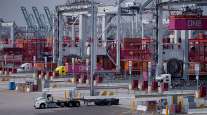Senior Reporter
Volume Growth Continues at Nation's Ports as US, China Resume Trade Talks

The nation’s ports continued to see steady growth in November cargo volume, as shippers moved goods to the United States from overseas in advance of the holiday shopping season and rushed to get cargo stateside ahead of expected tariffs on shipments from China.
The South Carolina Ports Authority said its facilities in November handled 188,585 20-foot equivalent units, or TEUs, compared with 163,592 for the same period last year, a 15.3% year-over-year increase. That figure is a record for the month.
Year-to-date officials said they were up 11% compared with last year.
“While the U.S. economy remains strong, there is increasing evidence that U.S. beneficial cargo owners advanced shipments from Asia in an effort to avoid tariffs,” SCPA CEO Jim Newsome said. “Although mostly to the U.S. West Coast — in view of the shorter transit times — there were 25 extra loaders employed by container shipping lines to meet this peak demand.”
#SCPorts Achieves Record November: https://t.co/aVHm3PgvKe #theworldconnectshere #chs52 Photo Courtesy: @cassidysvacay pic.twitter.com/Cj7fPcv1em — South Carolina Ports (@SCPorts) December 13, 2018
Newsome noted that most of those ships were due to arrive in December — setting the stage for another month of strong numbers — but he was less bullish on January. “The first calendar quarter of 2019, however, is much more uncertain in terms of outlook and considering strong volumes achieved in the same period in 2018,” he said.
In Savannah, Ga., officials with the Georgia Ports Authority said its facilities are on track to reach a record 4.36 million TEUs for 2018 and are already ahead of 2017’s strong pace. The ports achieved an 11.4% increase in container volumes in November, handling 344,507 TEUs, compared with 309,147 in November 2017.
“Cargo expansion related to growth in inland markets — as well as increased demand right here in the U.S. Southeast — have shifted the global logistics arena in Savannah’s favor, with more port users choosing to serve their customers via Georgia’s deepwater terminals,” Georgia Ports Authority Executive Director Griff Lynch said.
In a major port-related development, Georgia Gov. Nathan Deal announced Dec. 3 that the state will spend $90 million to construct an inland port in Gainesville, 55 miles northwest of downtown Atlanta. The Northeast Georgia Inland Port will link the Port of Savannah by rail to the 104-acre site. Gainesville is a poultry, carpeting and manufacturing hub in the state.
On the West Coast, the Port of Los Angeles, the nation’s busiest port, moved 832,331 TEUs in November, putting it on track to once again surpass 9 million TEUs in 2018.
Still, the November number is down 9.9% when compared to 2017, when it processed 924,256 TEUs and briefly set an all-time record for the port. That record was surpassed by the October 2018 record of 952,554 TEUs.
“In November, we processed a number of high-volume vessels brought into service to facilitate the holiday season cargo surge and accommodate the push to import cargo before tariffs that were previously scheduled to increase on Jan. 1,” Port of L.A. Executive Director Gene Seroka said.
Did you know our @portoflongbeach is about to have it’s best cargo year on record? It should end 2018 exceeding 2017’s record number of handling 7,544,507 twenty-foot equivalent units of container cargo!
: Anirudh Choudhary pic.twitter.com/yLuFGz4PVU — Long Beach Mayor (@LongBeachMayor) December 20, 2018
The nation’s second-busiest port, in nearby Long Beach, said it had a 1.5% increase in November TEU volume, moving 621,835 container units, compared with 612,659 in November 2017. Year-to-date the facility is up 7.3%, having moved 7,349,377 TEUs through the month of November.
Officials at the Port of Oakland, the seventh-busiest cargo facility, said a 15% increase in imports pushed total TEU volume to 219,123, a nearly 18% increase from the same month in 2017.
Officials credited the increase in cargo volume to continued strong consumer spending and importers’ rush to get cargo into the U.S. due to the threat of tariffs against China.
“We’re encouraged by our latest cargo statistics,” Port of Oakland Maritime Director John Driscoll said. “At the same time, we remain cautious as we approach the new year with uncertainty.”
U.S. and Chinese trade negotiators are slated to continue talks this month. Presidents Donald Trump and Xi Jinping agreed Dec. 1 to a 90-day postponement on more tariff hikes so the two sides could continue negotiations.
Trump agreed at that time to postpone a round of tariff hikes on $200 billion of Chinese imports planned for Jan. 1. On Dec. 14, Beijing responded by announcing a 90-day postponement on imposing a 25% duty on imported U.S. vehicles.




